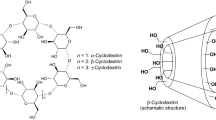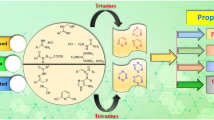Abstract
The physicochemical properties of a small library of 4-methyl-biphenylamide derivatives have been investigated by means of differential scanning calorimetry, thermogravimetric analysis and hot-stage microscopy. The obtained results show that positional isomerism has a significant influence on the thermal behaviour of the 4-methyl-biphenylamide derivatives; however, no clear relationship between functional group isomerism and thermal properties could be established. Ortho-substituted derivatives revealed two polymorphic forms, whilst the para-substituted derivatives exhibit three polymorphic forms. The ortho-substituted biphenylamides were more likely to generate metastable forms when cooled from the melt. Furthermore, the self-heating properties were revealed by the para-substituted 4-methyl-biphenylamide derivatives, in which the highly energetic crystallization processes raised the sample temperature by as much as 4 °C during cooling. Such a high-energy exothermic crystallization process suggests crystallization to be highly favourable, from a thermodynamic standpoint. Hence, the para-substituted derivatives are unlikely to generate amorphous forms. Pharmaceutical application of these compounds will depend on the solubility of their crystalline forms, but their manufacture may possess some challenges due to the number of monotropic polymorphic forms that may coexist.












Similar content being viewed by others
References
Jain ZJ, Gide PS, Kankate RS. Biphenyls and their derivatives as synthetically and pharmacologically important aromatic structural moieties. Arab J Chem. 2013. doi:10.1016/j.arabjc.2013.07.035.
Wang C, Dong J, Zhang Y, Wang F, Gao H, Li P, Wang S, Zhang J. Design, synthesis and biological evaluation of biphenyl urea derivatives as novel VEGFR-2 inhibitors. MedChemComm. 2013;4(11):1434–8.
Donato L, Mourot A, Davenport CM, Herbivo C, Warther D, Léonard J, Bolze F, Nicoud JF, Kramer RH, Goeldner M, Specht A. Water-soluble, donor-acceptor biphenyl derivatives in the 2-(o-Nitrophenyl)propyl Series: highly efficient two-photon uncaging of the neurotransmitter γ-aminobutyric acid at λ = 800 nm. Angew Chem Int Ed. 2012;51(8):1840–3.
Chen S, Fahmi NE, Bhattacharya C, Wang L, Jin Y, Benkovic SJ, Hecht SM. Fluorescent biphenyl derivatives of phenylalanine suitable for protein modification. Biochemistry. 2013;52(47):8580–9.
Costantino L, Barlocco D. Privilage structures as leads in medicinal chemistry. Curr Med Chem. 2006;13(1):65–85.
Baltus CB, Press NJ, Antonijevic MD, Tizzard GJ, Coles SJ, Spencer J. Synthesis of a biphenyl library for studies of hydrogen bonding in the solid state. Tetrahedron. 2012;68(45):9272–7.
Gracia-Fernández CA, Gómez-Barreiro S, Ruíz-Salvador S, Blaine R. Study of the degradation of a thermoset system using TGA and modulated TGA. Prog Org Coat. 2005;54(4):332–6.
Cheng K, Winter WT, Stipanovic AJ. A modulated-TGA approach to the kinetics of lignocellulosic biomass pyrolysis/combustion. Polym Degrad Stab. 2012;97(9):1606–15.
Brown ME, Maciejewski M, Vyazovkin S, Nomen R, Sempere J, Burnham A, Opfermann J, Strey R, Anderson HL, Kemmler A, Keuleers R, Janssens J, Desseyn HO, Li CR, Tang TB, Roduit B, Malek J, Mitsuhashi T. Computational aspects of kinetic analysis: part A: the ICTAC kinetics project-data, methods and results. Thermochim Acta. 2000;355(1–2):125–43.
Keuleers RR, Janssens JF, Desseyn HO. Comparison of some methods for activation energy determination of thermal decomposition reactions by thermogravimetry. Thermochim Acta. 2002;385(1–2):127–42.
Khawam A, Flanagan DR. Basics and applications of solid-state kinetics: a pharmaceutical perspective. J Pharm Sci. 2006;95(3):472–98.
Owusu-Ware SK, Chowdhry BZ, Leharne SA, Antonijević MD. Quantitative analysis of overlapping processes in the non-isothermal decomposition of chlorogenic acid by peak fitting. Thermochim Acta. 2013;565:27–33.
Burger A, Ramberger R. On the polymorphism of pharmaceuticals and other molecular crystals. I. Microchimica Acta. 1979;72(3):259–71.
Burger A, Ramberger R. On the polymorphism of pharmaceuticals and other molecular crystals. II. Microchimica Acta. 1979;72(3):273–316.
Author information
Authors and Affiliations
Corresponding author
Rights and permissions
About this article
Cite this article
Owusu-Ware, S.K., Cherry, A.J., Baltus, C.B. et al. Thermal analysis of novel biphenylamide derivatives. J Therm Anal Calorim 121, 437–452 (2015). https://doi.org/10.1007/s10973-015-4628-7
Received:
Accepted:
Published:
Issue Date:
DOI: https://doi.org/10.1007/s10973-015-4628-7




